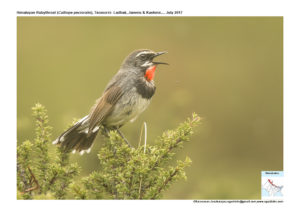White-tailed Rubythroat (chinese)

Chinese Rubythroat Calliope tschebaiewi
Etymology:
- Calliope : Greek Mythology- fine-voiced chief of the Muses, who presided over eloquence and heroic poetry
- Tschebaiewi : named after Named after Cossack naturalist Pamfili Tschebaeiv (fl. 1870)
Distribution in India: Breeds in Himalayas, winter visitor in foothills of Himalayas and North East India
Description: Size of 14–16 cm. Male has prominent white supercilium and white submoustachial stripe, broad area of deep red from chin to lower throat separated from submoustachial by narrow black malar stripe. The rest of head and upperparts are dark grey, flight-feathers are browner, tail is black, outer rectrices are with white tips and broad white bases. The breast is black, rests of the underparts are whitish, flanks are washed pale grey and buffish, a few scattered grey spots. The iris is dark brown; bill is black; legs are dark brownish-grey. The female is dark greyish-brown above and mostly grey below, with whitish supercilium and submoustachial stripe, narrow black malar stripe, and white chin and throat often with greyish streaks; tail feathers are tipped white, undertail-coverts are whitish. The juvenile is dark with very heavy spotting.
Habitat: It is found during breeding season in areas of alpine and subalpine bushes and dwarf willows, usually with scattered boulders or adjacent bare screes, and often near water in alpine zone from 2600m–4800 m. in winters it descends to lowlands in dense scrub.
Food Habits: It Insects, spiders, molluscs and small reptiles. It forages mainly on ground in cover.
Breeding Habits: They breed in May–Aug. They build a domed nest with large open side entrance, made from dry grass and lined with finer grass, concealed among rocks or roots or low in vegetation. They lay a clutch of 3–5 eggs. The incubation period is 13–14 days. The nestling period is 15 days. The nest is parasitized by Common Cuckoo.